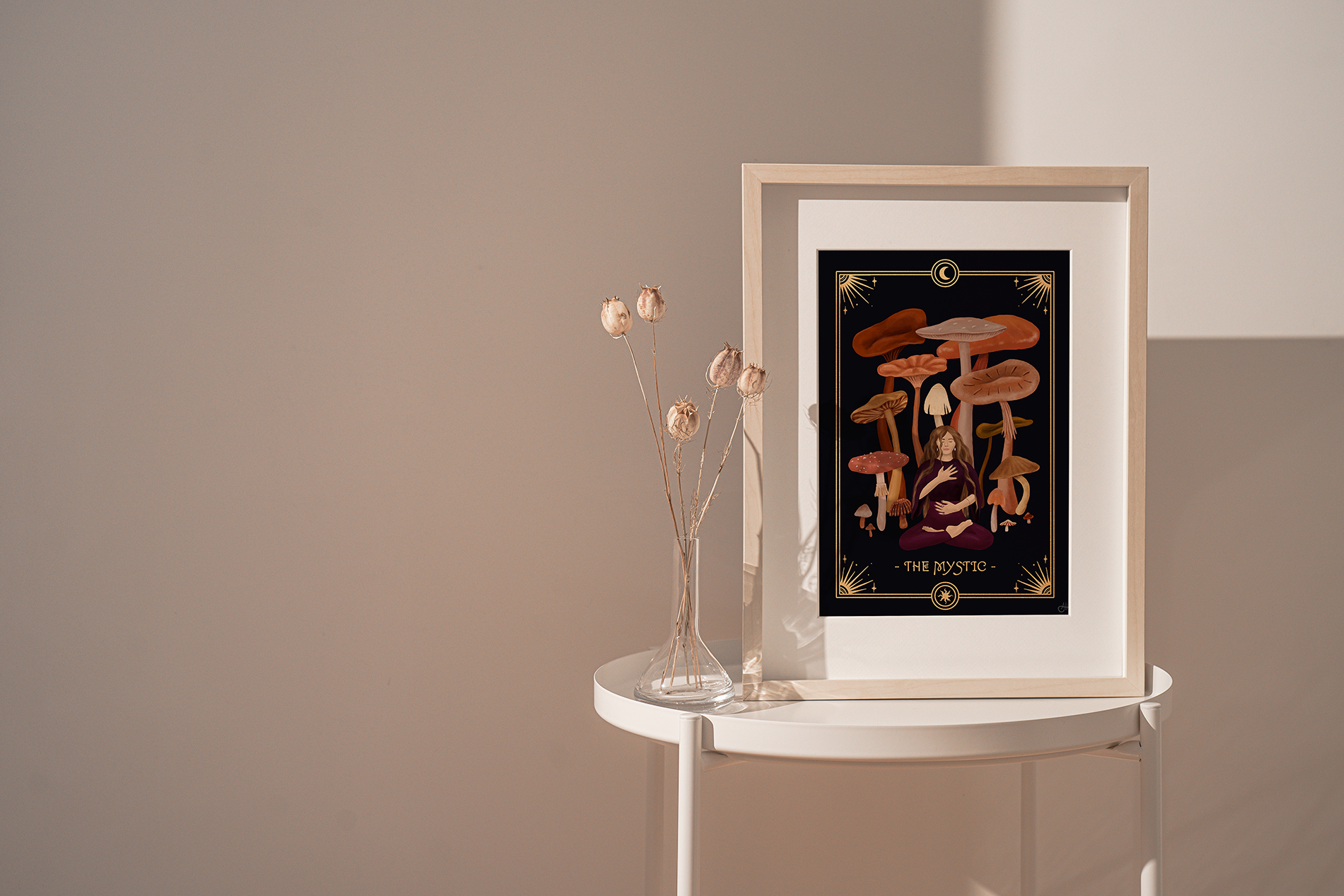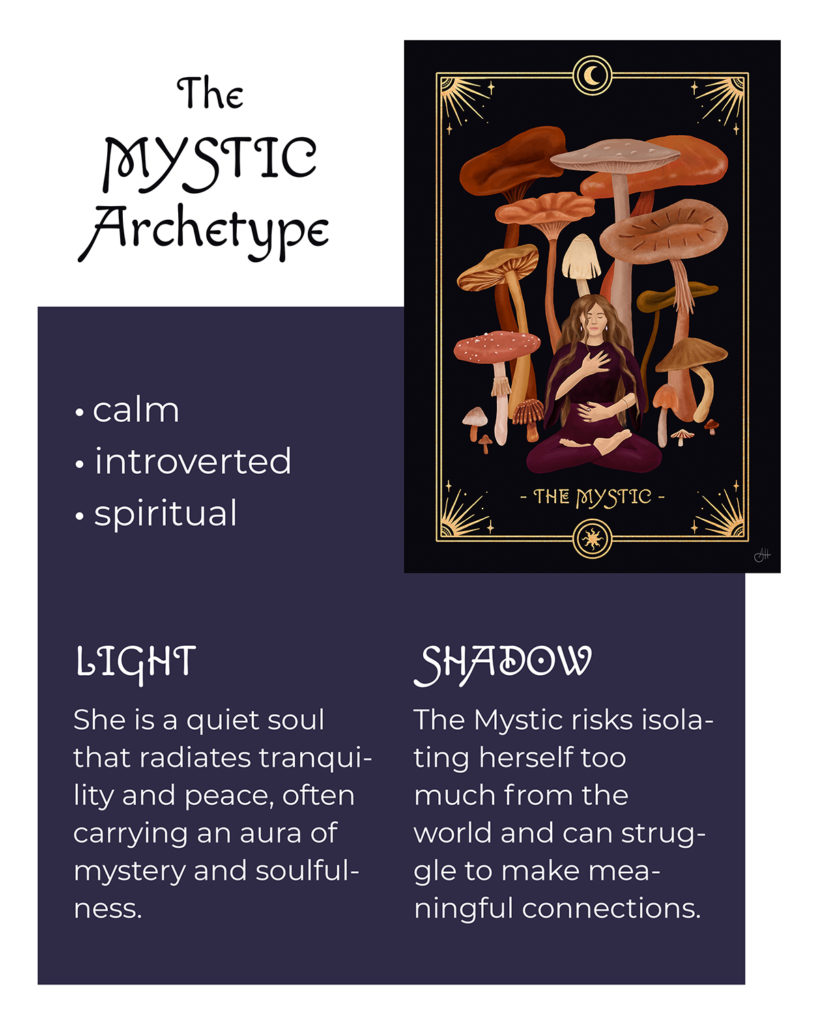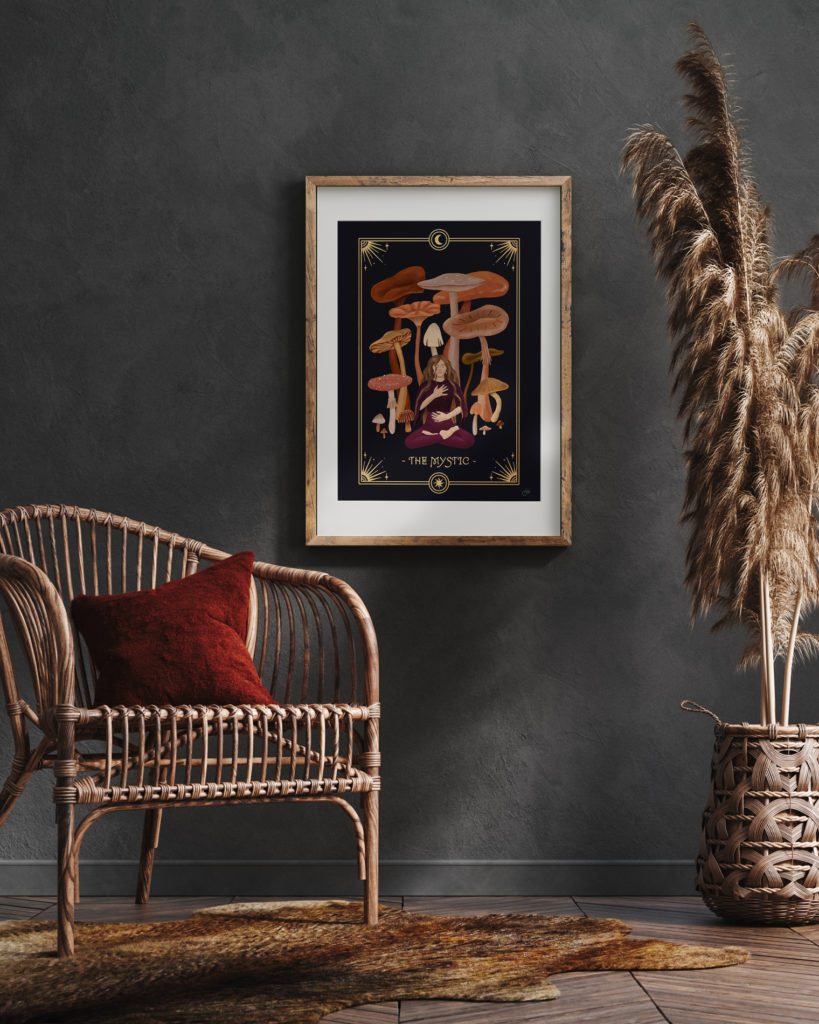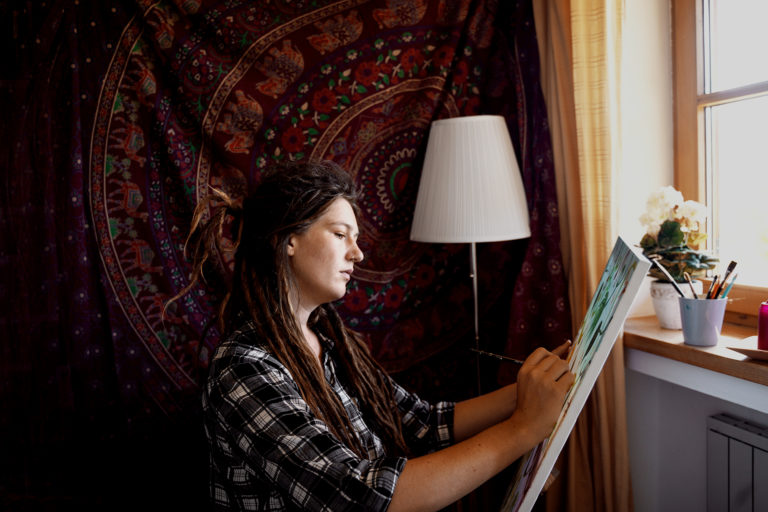
The Mystic Archetype –
Embody Serenity and Peace
Calm, soulful and intuitive – the Mystic Archetype is a very grounding person to be around.
She is a quiet soul and can be often found among introverts. „Still waters run deep“ perfectly captures the essence of this Feminine Archetype, sometimes also known as the Priestess.
If you‘re coming here from my 7 Feminine Archetypes Quiz, keep reading to learn more about the Mystic Archetype. Otherwise, I invite you to take the free quiz to find out which one fits you best:
Common Characteristics of the Mystic Archetype
Before we get to the juicy bits, let me share a quick overview of the Mystic Archetype with you – this already helps to get an idea of her main characteristics.
| Deepest desire: | Inner peace |
| Goal: | Living a meaningful life |
| Deepest fear: | Feeling disconnected and out of control |
| Signature move: | Withdraws from the outer world into her inner safe space |
| Hidden talent: | Slow living |
The Mystic Archetype is very inward-focused. Out of all 7 Feminine Archetypes, she is the most spiritually inclined – she loves exploring and getting in touch with her inner world.
The Mystic knows how to create a home within herself. Especially when she perceives a lack of balance, she dedicates her energy to creating harmony within herself and her surroundings.
Inner peace is her #1 priority. The Mystic has high levels of self-awareness and walks mindfully through life. That being said, she can be a little bit of a homebody and it would be no surprise to find her living in a tiny cottage in the countryside.
Her intuitiveness gives her insight into other people‘s actions, yet she prefers to remain in the background. While she may often be overlooked, she actually has a lot to contribute to a conversation when the topic is up her alley.
However, the Mystic Archetype does not like to waste time on superficial small talk. She is the perfect person to have deep conversations with. She especially enjoys them when she gets to learn something new about herself or is helping another person with her spiritual insight.
Her calm, reassuring presence can help to ground those around her and when her loved ones are in distress, the Mystic is a rock to hold onto.
Rituals can be very important for the Priestess and she finds inner peace in simple, everyday actions. While doing so, she does not mind spending time on her own – she is her own best friend. At times, she may feel more comfortable among animals than people.
The Mystic is not attached to the material world or emotions – her priority is finding meaning in what she does and living a wholesome life. Her path can be quite unique since she is deeply in touch with her soul’s calling – she pursues her own path with vision and passion.
Her serenity and warmth can make her very magnetic, even though she might not be aware of it herself. She often radiates an aura of profound wisdom and „old soul“ energy.
The Mystic Archetype‘s Shadow and Weaknesses
Your light and your dark are two sides of the same coin – one cannot exist without the other. Let‘s get to know the Mystic Archetype‘s shadow.
Is the term ‚shadow‘ new for you? You can read more about it here but basically it refers to the ‚dark‘ side of the human psyche, often hiding in shame, trauma, and fear.
The Mystic‘s connection to the inner world can be a source of great strength, however, when taken too far, she potentially could lose touch with reality. It is important for her to stay grounded in order to not withdraw from ‚real life‘ too far or become emotionally detached.
Socially, the Mystic in her shadow may struggle with her introversion. Since this archetype tends to be not very assertive, she may feel overlooked or miss the opportunity to speak her mind – business meetings are the kind of stuff her nightmares are made out of.
In consequence, she is at risk of isolating herself more than what is healthy when she feels like she does not truly belong. Especially in large groups, she struggles to find her place.
The Mystic typically has a small, intimate circle of friends. However, if she does not learn how to express her feelings and take steps toward others, she might end up feeling rather lonely due to her inability to connect with others as deeply as with herself.
Despite appreciating solitude and not necessarily wanting to fit in, the Mystic can at times feel a little misfit in today‘s society and overwhelmed by the hectic pace of modern life.
Personally, I love journaling as a practice to explore the deeper aspects of myself. If you’re a Mystic just like me, here is a set of questions that might be particularly helpful for you:
- Which rituals help me to find balance?
- How do I want to show up today?
- Which part of my life needs more attention?
- What are my values?
- How can I counterbalance my tendency to self-isolate?
- Do I contribute to my feelings of loneliness? Are they justified?
- In which moments could I speak up more?
- What makes me feel connected to myself?

If these prompts resonated with you and you feel called to dive deeper, the Feminine Archetype Workbooks extend the experience, offering an abundance of insightful prompts to guide you further.
Mystic Archetype Examples
Well-known examples of the Mystic Archetype are:
- Saint Teresa of Avila
- Rumi
- Annie Hall
- Grace Kelly
- ENYA
Examples of the Mystic Archetype are actually hard to find, since she prefers to stay in the background and does not actively look for recognition. However, her special aura might attract an unexpected amount of fans!
Grace Kelly is a wonderful example of how the Mystic can attract and fascinate. Her „icy“ presence shows the typical detachment often found in Mystics – apparently, she also struggled to connect with her children despite her love for them.
When this famous Mystic was a child herself, she is said to have been introverted, serene and somewhat fragile. Despite her later fame, Grace Kelly enjoyed simple activities like gardening and wanted to remain „ordinary“.
Mystics are often found in the arts – expressing their creativity through acting, music, or poetry. If you can think of more famous examples, please let me know in the comment section and I’ll add them to the list!

Was the Mystic Archetype defined by Carl Jung?
No, the Mystic Archetype was not authored by Carl Jung nor is there any equivalent in his writings.
The origin of the Mystic Archetype can be traced back to Jean Shinoda Bolen who first defined the 7 Feminine Archetypes in “Goddesses in Everywoman: A New Psychology of Women”.
However, she merely spoke of the „Hestia Archetype“ which is the mythological equivalent of the Mystic Archetype. It is unclear where the designation ‚the Mystic‘ is coming from but it certainly fits the spirit of this archetype.
Jean Shinoda Bolen is a psychatriast and Jungian psychoanalyst. She states that the Hestia Archetype provides a sense of wholeness and is characterized by her inward-facing consciousness.
The Mystic, according to Bolen, is a hearthkeeper who may also find pleasure in household activities and can often be found in spiritual or religious communities.
The Mystic Archetype in Mythology
The Mystic Archetype in mythology is represented by Hestia, the Goddess of Hearth. When you wanted to make your house a home, the first offering would traditionally go to Hestia.
She is also associated with the warmth of the fire which perfectly describes the cozy, calming spirit of the Mystic Archetype.
Hestia is one of the virgin goddesses who swore to never marry. Even though Mystics can be devoted, loving mothers, they might have different priorities and prefer to pursue a more self-focused path in life.
Hestia was rarely depicted, but rather spiritually felt through the fire – she provides light, warmth and nourishment. The fireplace, traditionally, is a place for the family to gather, a sacred sanctuary to rest our souls and get together in community.
Any Mystic woman can fulfill the same function: Providing homely warmth for others and offering a safe space to rest and connect with the quiet inner world.

Behind the artwork: Powerful symbolism of the Mystic Archetype
Since my main archetype is the Mystic, the creation of this artwork was characterized by a beautifully soft flow – inspiration came to me very easily.
I wanted to depict the Mystic Archetype as a soulful, calm woman. Since Mystics are often drawn to or benefit from meditation, I painted her in a meditative moment of connecting with her heart.
With her eyes closed, she is focused on her inner world, sensing what is happening within.
The Mystic can be fascinated by the natural world and even psychedelics as a tool for expanding her consciousness. This is why you can find her surrounded by a magical mushroom forest, a beautiful symbol of the wonders of the world.
Mushrooms grow even in dark and unexpected places. They symbolize your potential to evolve and transform.
As a fellow Mystic, I hope this artwork will bring lots of peaceful energy into your home – it can enhance any room you want to feel especially cozy and calm, like your yoga space or your favorite armchair next to the fireplace.
How to Embody the Mystic Archetype
Would you like to gain more balance and connection with your inner world? Here are some ideas on how you can embody the Mystic or Priestess Archetype in your everyday life.
P.S. Have a look at these handpicked books for the Mystic (and each of the other 6 Feminine Archetypes).
Go on a retreat
The Mystic Archetype often shows up when we really need a break and take some time off. Spiritual seekers find fulfillment by spending some time in an ashram or participating in a yoga or meditation retreat.
Meditate
Listening to what goes on within you ideally should be part of your daily routine. You can embody the Mystic archetype by dedicating more time to meditation – even 10 minutes per day can already benefit you.
Write poetry
To get in touch with your creative side, try to express your soul by writing. Poetry or journaling are great outlets for the Mystic to process her deep feelings and thoughts.
Find your north star
The Mystic is a great archetype to embody when you want to get closer to your values and find out what is meaningful in your life. Do a little soul-searching and find out your personal purpose.
If you are ready to journey deeper into the expression of the Mystic…
…the Feminine Archetype Workbooks are here to guide you! Some topics we explore specifically in the Mystic Workbook are how to:
- stay connected to your inner zen (even when life gets hectic)
- get in touch with the divine, wonder, and synchronicity, fully exploring your spiritual side
- reflect on your path and purpose
- nurture a growth mindset to navigate any challenge you encounter
- embrace solitude and transform loneliness into connection that nourishes your soul
- allow more intimacy into your life
- overcome the fear of being seen and accomplish more by taking deliberate action
- live at your own pace in a rushed modern world and reclaim your time and energy
I hope you enjoyed this little excursion into the magical world of the Mystic Archetype. Did you learn something new about yourself today? Please share with us in the comments below!









Thank you for this💙
Thanks for being here, Pamela!
Don’t forget ENYA—she would be a great example of a mystic.
Ohh, yes, true! Not too much is known about her but her ethereal music and reclusive life do fit the Mystic perfectly! I’ll add her to the list of examples, thank you so much 🙂
Thank you this is so me and I’ve never known of this but I love it
This was a wealth of great information. The Mystic is the perfect description of me. I am working on the creating more meaningful connections & expressing my emotions parts because it is something that I’ve always struggled with.
Thank you so much, I’m happy to hear this was helpful for you! The Mystic was quite easy to describe for me since it is also my main archetype and I can 100% relate to your struggles. I’ve been working on them actively for quite a while, too, and it definitely does get easier – it’s beautiful to see how we can move into a “healthier” / more confident version of our archetype by facing our shadows 🙂
Eu me senti acolhida sabendo que sou inteirinha assim, e há mais pessoas como eu. 🌼
Yes, you’re wonderful just as you are – and there are many Mystics out there 🙂 thank you for being here, Amanda!
Thank you, this was lovely to read
Glad you enjoyed the article, Kharla! 🙂
While reading this article, I felt like somebody finally gets me! This is definitely me. I am working on connecting with my emotions and saying how I feel. This article was beautiful.
Thank you so much! It’s good to hear you felt seen by this – and I’m proud of you for doing the work to understand and voice your emotions better, that will certainly have a profound impact on your life. Much love to you. Anna
I think Erykah Badu is a fantastic example of a mystic. She started her career in the, (what was at the time called) Neo-soul genre of music. Everyone that meets her says that she has a magical quality about her. Currently, she is still making music but is also a birth doula.